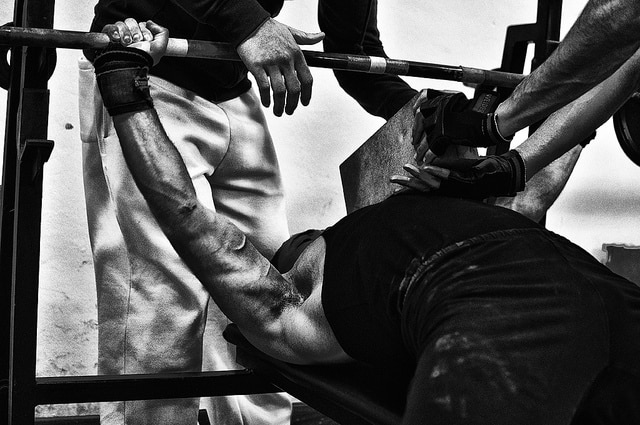Is Training To Failure Worth It?
October 28, 2015
First, a brief story about a recent gym encounter. Then, a few lessons I urge you to take to heart.
The story I’m about to tell is important if you want long term gains in ways that minimize your risk of injury or joint stress. So here we go. Listen up.
It was 6:00 pm on a Monday night.
I glanced at my watch. There was Dave, walking out right on time for his Monday chest day.
Dave’s a former bodybuilder in his late 30’s. He now trains to keep in shape — and keep up with his kids. l bring up old workout ideas from juiced out dudes in the old muscle mags.
We shoot the shit, talk training, some football, and go on with our training. I admire Dave. He’s in good shape and loves to get after it, both admirable qualities.
Problem is, he’s always beat up. Shoulder, knee, back… you name it. When it comes to training, he knows only one gear: balls to the wall.
This particular night, Dave asked me to spot him on a bench press. He was going for six heavy reps.
One, two, three, and four were all on the money.
Five was shaky.
Six was a battle.
As in:
Twerking on the bench, gasping for air, and coming up with the right arm, then the left arm.
Rather than racking the weight after six quality reps, Dave shooed me away. He pushed on for more reps until every ounce of energy was destroyed. I ended up performing a bent-over row to peel the bar away.
I asked him, “Why didn’t you stop at five?”
“I had to get six, and then I felt like going to failure. No pain, no gain, bro.”
Rather than give unsolicited advice, I just said “Nice work, just back it off every few weeks, won’t you?”
We parted ways. And now I’m at home reflecting on the moment.
I’d never advocate training like a wimp. But training to failure should have no place in your training.
But What Is Training To Failure?
Training to failure is continuing an exercise to the point of technical breakdown. Meaning: you can no longer maintain good technique and complete a rep.
For example: Dave doing a bench press in a way that his left arm couldn’t keep up with his right arm. The weight came tumbling down towards his chest and throat. Not good!
An another day, he might be squatting when his back buckles. He might finish with an uneven, supra-maximal Good Morning with the help of a spotter.
His musculosketal system and central nervous system (CNS) couldn’t complete the action.
His body flipped him off and said: “No, you can’t do this, I’m going down.”
To get one more rep, he compromised body position and increased injury risk to get one more ego-boosting rep.
Is Training To Failure Worth It?
Let’s agree the gym is a great place to relieve stress and to build your mind and body.
Unless lifting is your primary sport, or the safety measures are in place to reduce risk, the risk of training to failure isn’t worth the reward.
Think about it:
You’re screaming your lungs out and kicking your feet in the air doing a bench press? Why? Because your body cannot hold position while a loaded piece of steel and gravity are pushing it to guiloitine your face.
There’s A Better Way
Optimizing performance and hitting your goals without undue risk and injury is the name of the game.
Instead of chasing annihilation, finish your work sets knowing you could blast out one or more reps without changing technique. On an explosive exercise, that means rep speed hasn’t slowed down and technique is still solid.
Aim For Eustress, Not Distress
There are two stresses from training: distress and eustress.
Distress: acute physical or mental suffering; affliction; trouble.
Eustress : stress that is deemed healthful or giving one the feeling of fulfillment.
You want an athletic body: one that looks strong and muscular because it is. That means you need to train hard to create stress, stimulating your body to adapt and grow stronger and more resilient. After all, stress is necessary to forge a stronger body and adapt to training.
Read More About Recovery and Adaptation Here
Unfortunately, too many of us type A athletes confuse distress and suffering with with ultra-intense methods vital to training.
You know the type.
They think if you’re not bleeding, puking, crying (or a combination of the three) they’re not training hard enough.
Well, that’s bullshit.
What we really want and need is eustress: a stimulus that signals change, but isn’t too brutal on the body. Train for stimulation, not annihilation.
What I Recommend
- On explosive exercises (like cleans and jumps): maintain sound technique and rep speed. If your technique changes and you slow down, end the set and increase rest.
- If your working other compound exercises for strength and muscle: make sure your first and last rep look the same, even if the last is a bit slower.
- If you’re going to go until failure: use light isolation pump work. Meanwhile…
What Happened The Next Day
I got a text the next day from Dave saying his shoulder was flaring up again. He said he was going to back off training for a bit.
It sucks. I felt for him. I respected his dedication and training intensity.
We can all learn from Dave.
If you’re compromising body positions and destroying yourself in every workout, you’re missing the point. You’re crushing your central nervous system, limiting strength gains, and increasing your chance of injury.
There are risks and rewards with everything we do. And they must be managed. Balance risks and rewards by keeping the big picture in mind. You’ll end up training smarter and performing better.
UPDATE:
Wow! This post really struck a chord, especially with my fellow fitness professionals.
More than a few wrote to say: “This sounds like me.” They said they knew they had a tendency to overdo things, but weren’t quite sure how to do things differently.
I feel your pain, bro! And maybe I can help.
Please fill out the form below. If you qualify, we can talk further on a free Skype call. And then maybe I can help coach you to success by building on your great work ethic in the best possible way.










[…] Habit Creep: The Proven, Reasonable, and Totally Unsexy Way To Be More Successful by James Clear Is Training To Failure Worth It by Eric Bach On Focus, Taking Risks, and Living Your Life To The Fullest by Slyvon […]
[…] Is Training To Failure Worth It? (Bach Performance) […]
[…] Is training to failure worth it? via Eric Bach […]